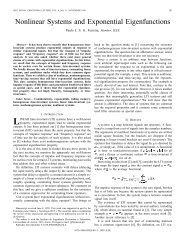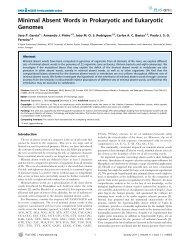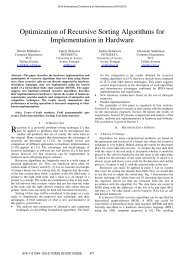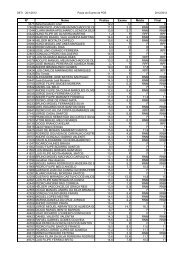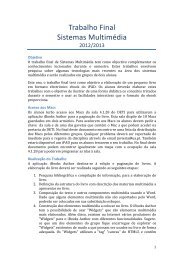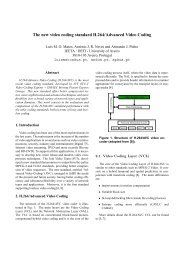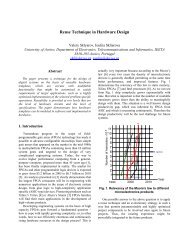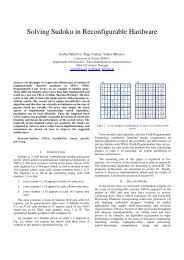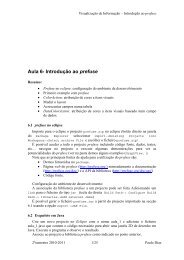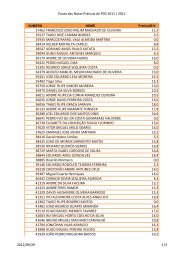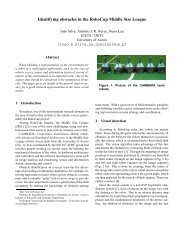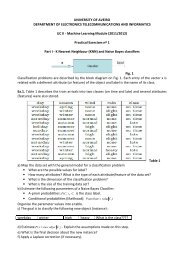DATA SHEET - IEETA
DATA SHEET - IEETA
DATA SHEET - IEETA
You also want an ePaper? Increase the reach of your titles
YUMPU automatically turns print PDFs into web optimized ePapers that Google loves.
Philips Semiconductors Product specification<br />
8-bit microcontroller with on-chip CAN P8xC592<br />
16 OSCILLATOR CIRCUITRY<br />
The oscillator circuitry of the P8xC592 is a single-stage<br />
inverting amplifier in a Pierce oscillator configuration. The<br />
circuitry between XTAL1 and XTAL2 is basically an<br />
inverter biased to the transfer point. Either a crystal or<br />
ceramic resonator can be used as the feedback element to<br />
complete the oscillator circuitry. Both are operated in<br />
parallel resonance. XTAL1 (pin 34) is the high gain<br />
amplifier input, and XTAL2 (pin 33) is the output<br />
(see Fig.23). If XTAL1 is driven from an external source,<br />
XTAL2 must be left open (see Fig.24).<br />
17 RESET CIRCUITRY<br />
The reset pin RST is connected to a Schmitt trigger for<br />
noise rejection (see Fig.25). A reset is accomplished by<br />
holding the RST pin HIGH for at least two machine cycles<br />
(24 oscillator periods). The CPU responds by executing an<br />
internal reset. During reset ALE and PSEN output a HIGH<br />
level. In order to perform a correct reset, this level must not<br />
be affected by external elements.<br />
Also with the P8xC592, the RST line can be pulled HIGH<br />
internally by a pull-up transistor activated by the Watchdog<br />
timer T3. The length of the output pulse from T3 is<br />
3 machine cycles. A pulse of such short duration is<br />
necessary in order to recover from a processor or system<br />
fault as fast as possible.<br />
During Power-down a reset could be generated internally<br />
via the CAN Wake-Up interrupt. Then the RST pin is pulled<br />
HIGH for 6144 machine cycles. In this case the<br />
CAN-controller is not reset.<br />
If the Watchdog timer or the CAN Wake-Up interrupt is<br />
used to reset external devices, the usual capacitor<br />
arrangement for Power-on-reset (see Fig.26) should not<br />
be used.<br />
However, the internal reset is forced, independent of the<br />
external level on the RST pin.<br />
The MAIN RAM and AUXILIARY RAM are not affected.<br />
When VDD is turned on, the RAM content is indeterminate.<br />
A reset leaves the internal registers as shown in Table 83.<br />
1996 Jun 27 70<br />
handbook, halfpage C1<br />
20 pF<br />
C2<br />
20 pF<br />
XTAL1<br />
XTAL2<br />
MLA888<br />
34<br />
33<br />
Fig.23 P8xC592 oscillator circuit.<br />
handbook, halfpage<br />
external clock<br />
(not TTL compatible)<br />
not connected<br />
XTAL1<br />
XTAL2<br />
MLA889<br />
Fig.24 Driving P8xC592 from an external source.<br />
handbook, halfpage V<br />
DD<br />
RST<br />
RRST<br />
on-chip<br />
34<br />
33<br />
overflow timer T3<br />
wake-up reset<br />
CAN<br />
CPU<br />
Fig.25 On-chip reset configuration.<br />
MGA170 - 1



